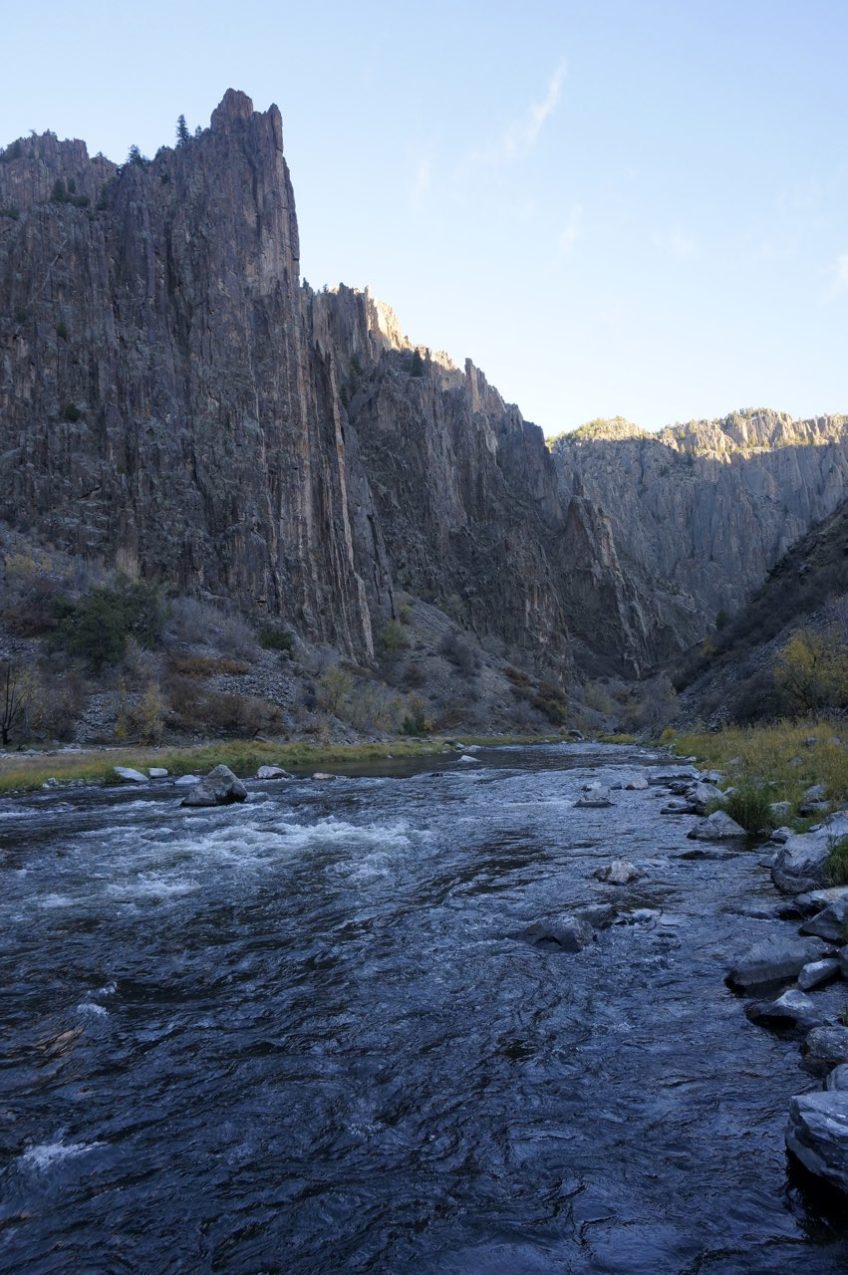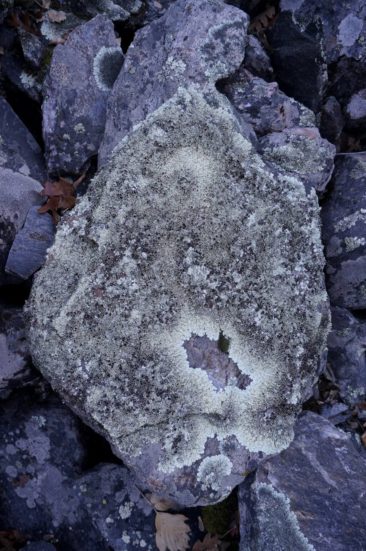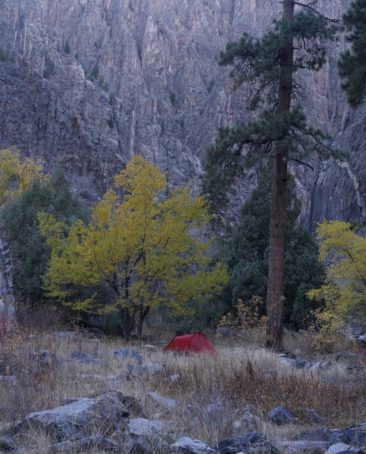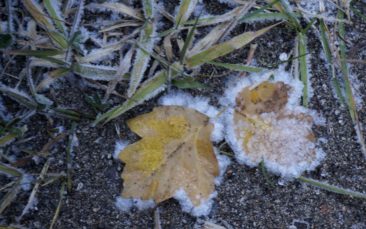After leaving the camaraderie and comfort of Telluride, I ended up in Montrose, just a hop, skip, and a jump away from Black Canyon of the Gunnison National Park (Black Canyon). With most of the day ahead of me, I filled up my tank, stopped by the local Salvation Army, and then headed for the park. As usual, I went directly to the visitor’s center to check out the film featuring all of the park’s highlights. Black Canyon’s video, unlike many others, focused almost entirely on the geology and human history of the canyon. Where wildlife and biodiversity often filled 30-50% of most other park’s videos, Black Canyon’s focus was elsewhere. Later, as I hiked down into the canyon, I began to wonder if the environment was too harsh for many plants and animals to thrive. At the bottom of the canyon, sunlight is a luxury, not a commodity, preventing many of the processes that sustain life elsewhere. Still, I saw large hawks and ravens riding the thermal currents of the canyon, heard fish slapping the water as they leapt for low flying insects, and stumbled upon mammalian tracks of all sizes imprinted on the light dusting of snow and ice. Clearly, animals and plants clung to life here, but the epic geology and human struggle for exploration took priority.

Instead, this park’s film focused on the canyon’s “discovery” by John Williams Gunnison in 1853. He described it as “impenetrable”. Although this phrasing undoubtedly acted as a tempting challenge to railroad tycoon’s like William Jackson Palmer (who would later succeed in creating a railroad in the canyon in 1881) and explorers like Bryan Bryant, it is one of the most imposing and rugged physical features I have ever seen. At the heart of Black Canyon is the water, which drops over 34 feet per mile. Flow rates and changes in elevation are not necessarily how we think about rivers, but they are essential attributes of any river. For example, the Colorado River drops just over 7 feet per mile in the Grand Canyon. The Gunnison River has spent eons pulsing through this canyon, wearing through the walls of gneiss and schist that now line the canyon. Those walls are far more physically impressive, even awe-inspiring, than the river below, but they are integrally connected.

The water of the Gunnison has also played an essential role in the development of the surrounding Uncompaghre Valley. Defended by the canyon walls, the waters of the Gunnison felt untouchable. Yet the arid alpine valleys of the Uncompaghre needed water badly. In 1909, laborers finished a four-year struggle through the tough walls of Black Canyon, diverting the river through a 6-mile tunnel. Now, livestock and cropland fill the surrounding valley. The level of human ingenuity and effort that went into that tunnel is truly impressive.

The sheer walls of Black Canyon are breathtaking. From the rim, they often drop vertically more than 2,000 feet to the river below. The massive plateaus of the Grand Canyon are non-existent here; these walls are straight up and down. Peeking over the edge is a simultaneously terrifying and exhilarating experience. The imposing-nature of these walls is heightened by the width of the canyon. In some places, the north and south rims are only separated by 40 feet of open air. It is a narrow, but deep scar on the earth’s surface. The name “Black Canyon” comes from the shadows that shroud the canyon walls for most of the day. Some sections of the canyon only receive sun for thirty minutes every day. This shadowy phenomenon also makes it notoriously difficult to photograph. My photos do not do this canyon justice.

As far as my own adventuring in the canyon, I spent my first day driving around the South Rim before descending to the bottom of the canyon on day two, which proved rather exciting and quite chilly. Although well-maintained roads run along the north and south rims, the park limits access to the inner-canyon. Only allowing 15 hikers per day, per route, adventuring in the depths of the canyon is something of a treat. With four routes on the south rim and three on the north, the number of inner-canyon explorers is limited each day to just over a hundred. I doubt, however, that all of those spots fill up on a regular basis. The sheer walls of Black Canyon are imposing enough that few people venture into their shadows. With free backcountry camping at the bottom, I knew I was up for the trip.

Descending the south rim is particularly difficult because the slope faces north, making any snowfall all but permanent as long as the temperatures dip below freezing. Dropping below the rim on the Gunnison Trail, I instantly found myself in total shade and increasingly chilly temperatures. The trail, which was a network of animal trails that traversed a steep ravine, was slick, inconsistent, and unstable. The park service had even installed an 80-foot chain to assist hikers during a particularly steep section.

2,000 feet below where I had begun, I ran into a young man who was working with the park that season. That day, we were the only two people in the canyon. Amazingly, we had more in common than you might imagine: We had both grown up in Bayfield, WI. I didn’t know who he was, but we shared memories of one of my favorite places on the planet. He, however, was headed up as I continued to descend to my campsite. That night, I spent a cold night alone in that massive canyon, listening to the roar of the Gunnison River as it hurtled past me. I can’t say it was the most restful sleep I have ever had, but waking up in the belly of that canyon was something special.
Climbing back out was surprisingly more difficult than I had imagined. The going was slow, but the footing was sturdier. The chill that had accumulated within me over the night soon evaporated as I huffed and puffed back up to my car. Plugging back into Freakonomics and Planet Money, I headed south, crossing the Gunnison and traveling along the north rim. Traversing along the rolling hills above the canyon, I made my way for McClure Pass, en route to Aspen. As I descended from the pass, I stumbled upon Penny Hot Springs alongside the highway. Now that put some color back in my cheeks!







One Response
Jean Cronon
I started a comment but it seems to have disappeared when I went back to look at your map to bind out where Black Canyon is located. It must be in Colorado. Dave and I never visited that place. I can see you starting to shiver in that narrow canyon where there is daylight for just a short time. Fortunately you were prepared for it.